LCBS5001: Strategic Management Analysis of Tesco PLC
VerifiedAdded on 2023/02/01
|18
|4903
|24
Report
AI Summary
This report presents a comprehensive strategic analysis of Tesco, a multinational retail giant. It begins with an introduction to strategic analysis and provides background information on Tesco's operations and its journey within the retail industry. The analysis employs several strategic frameworks, including Porter's Five Forces to evaluate the competitive environment of the UK retail industry, and the resource-based view to assess Tesco's internal strengths and weaknesses. Furthermore, a VRIO analysis and strategy clock are utilized to evaluate Tesco's competitive advantages and strategic positioning. The report culminates in strategic recommendations for Tesco, based on the preceding analysis, and a final conclusion summarizing the key findings. The report includes references to support the analysis and findings.
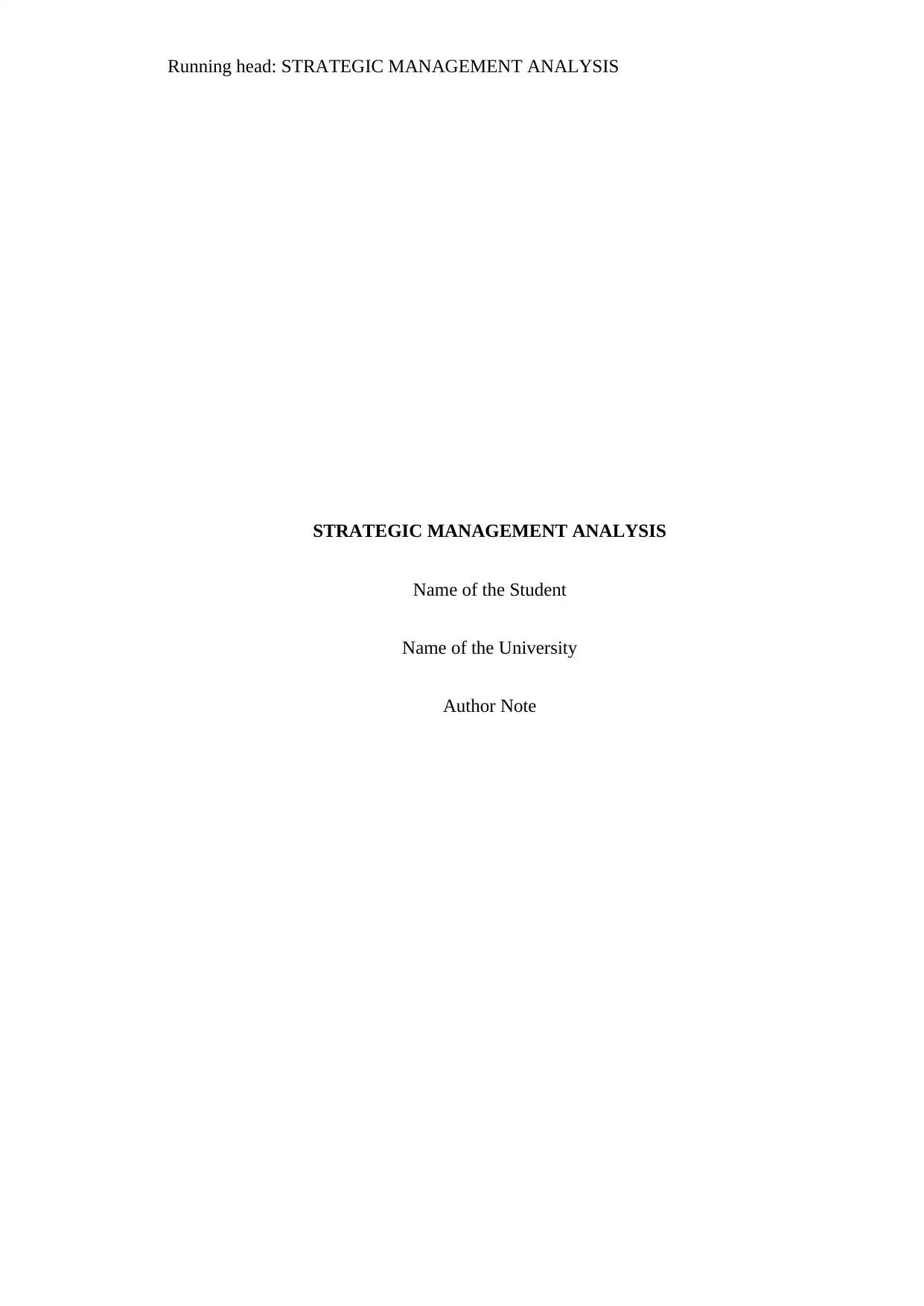
Running head: STRATEGIC MANAGEMENT ANALYSIS
STRATEGIC MANAGEMENT ANALYSIS
Name of the Student
Name of the University
Author Note
STRATEGIC MANAGEMENT ANALYSIS
Name of the Student
Name of the University
Author Note
Paraphrase This Document
Need a fresh take? Get an instant paraphrase of this document with our AI Paraphraser
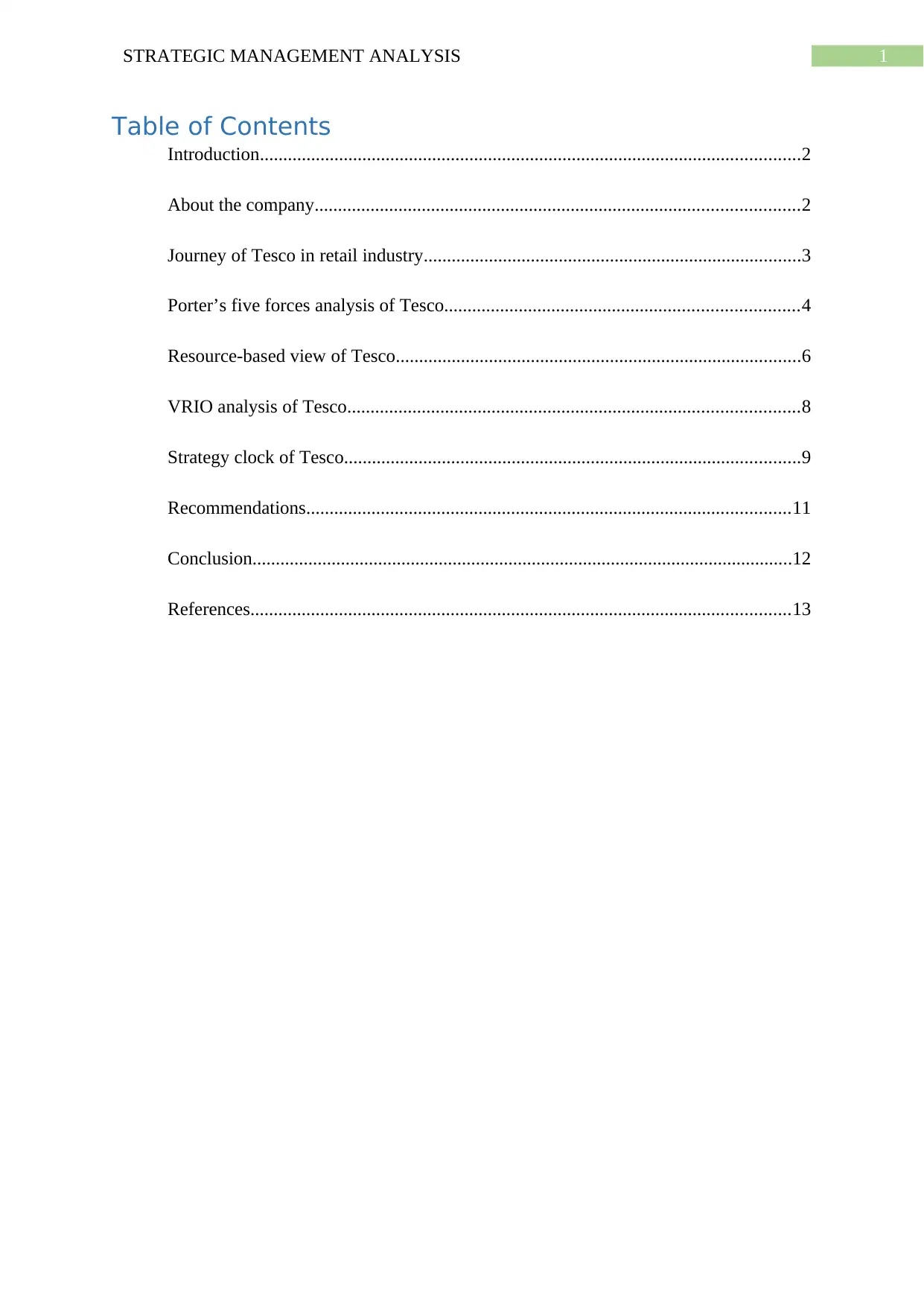
1STRATEGIC MANAGEMENT ANALYSIS
Table of Contents
Introduction....................................................................................................................2
About the company........................................................................................................2
Journey of Tesco in retail industry.................................................................................3
Porter’s five forces analysis of Tesco............................................................................4
Resource-based view of Tesco.......................................................................................6
VRIO analysis of Tesco.................................................................................................8
Strategy clock of Tesco..................................................................................................9
Recommendations........................................................................................................11
Conclusion....................................................................................................................12
References....................................................................................................................13
Table of Contents
Introduction....................................................................................................................2
About the company........................................................................................................2
Journey of Tesco in retail industry.................................................................................3
Porter’s five forces analysis of Tesco............................................................................4
Resource-based view of Tesco.......................................................................................6
VRIO analysis of Tesco.................................................................................................8
Strategy clock of Tesco..................................................................................................9
Recommendations........................................................................................................11
Conclusion....................................................................................................................12
References....................................................................................................................13
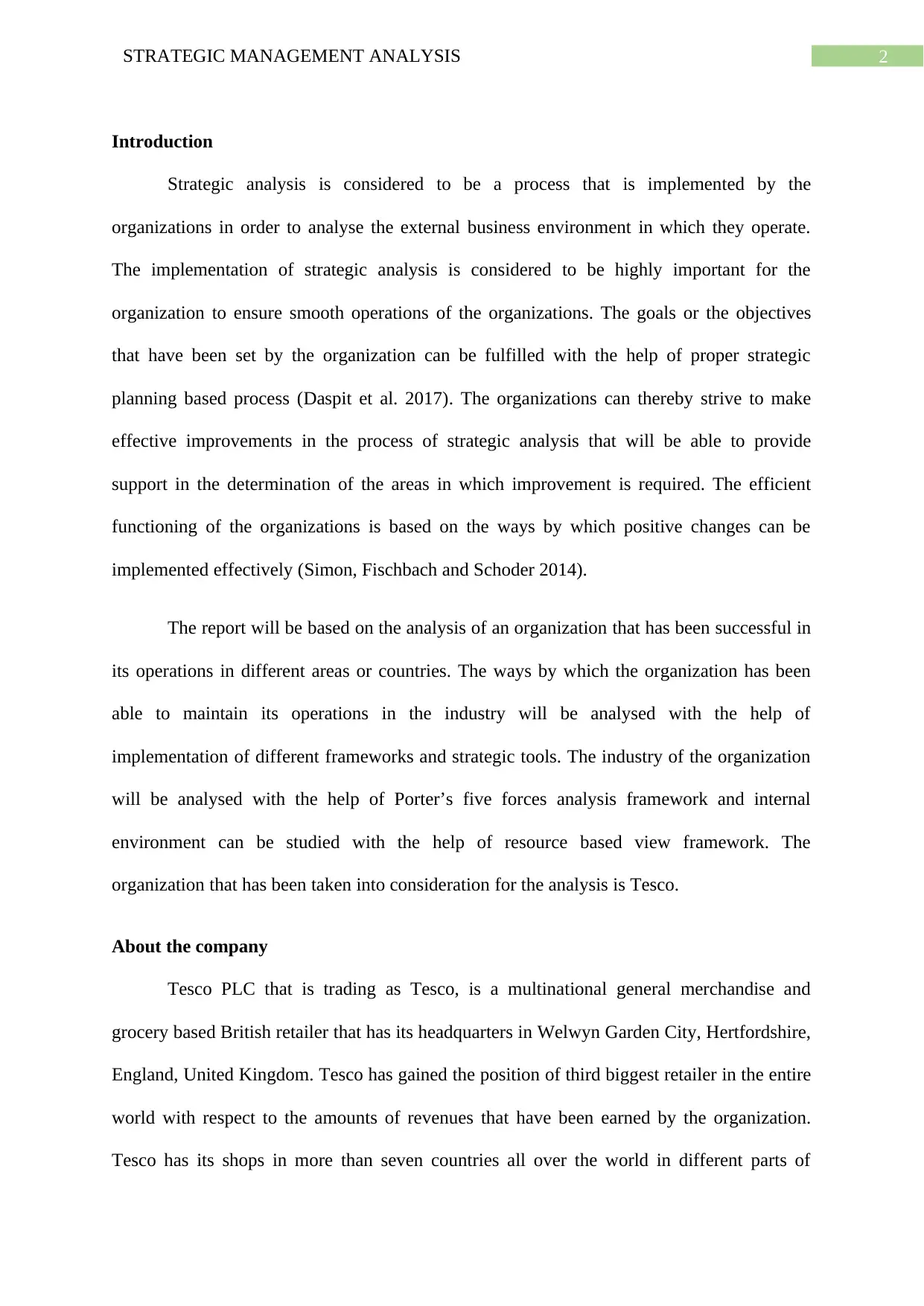
2STRATEGIC MANAGEMENT ANALYSIS
Introduction
Strategic analysis is considered to be a process that is implemented by the
organizations in order to analyse the external business environment in which they operate.
The implementation of strategic analysis is considered to be highly important for the
organization to ensure smooth operations of the organizations. The goals or the objectives
that have been set by the organization can be fulfilled with the help of proper strategic
planning based process (Daspit et al. 2017). The organizations can thereby strive to make
effective improvements in the process of strategic analysis that will be able to provide
support in the determination of the areas in which improvement is required. The efficient
functioning of the organizations is based on the ways by which positive changes can be
implemented effectively (Simon, Fischbach and Schoder 2014).
The report will be based on the analysis of an organization that has been successful in
its operations in different areas or countries. The ways by which the organization has been
able to maintain its operations in the industry will be analysed with the help of
implementation of different frameworks and strategic tools. The industry of the organization
will be analysed with the help of Porter’s five forces analysis framework and internal
environment can be studied with the help of resource based view framework. The
organization that has been taken into consideration for the analysis is Tesco.
About the company
Tesco PLC that is trading as Tesco, is a multinational general merchandise and
grocery based British retailer that has its headquarters in Welwyn Garden City, Hertfordshire,
England, United Kingdom. Tesco has gained the position of third biggest retailer in the entire
world with respect to the amounts of revenues that have been earned by the organization.
Tesco has its shops in more than seven countries all over the world in different parts of
Introduction
Strategic analysis is considered to be a process that is implemented by the
organizations in order to analyse the external business environment in which they operate.
The implementation of strategic analysis is considered to be highly important for the
organization to ensure smooth operations of the organizations. The goals or the objectives
that have been set by the organization can be fulfilled with the help of proper strategic
planning based process (Daspit et al. 2017). The organizations can thereby strive to make
effective improvements in the process of strategic analysis that will be able to provide
support in the determination of the areas in which improvement is required. The efficient
functioning of the organizations is based on the ways by which positive changes can be
implemented effectively (Simon, Fischbach and Schoder 2014).
The report will be based on the analysis of an organization that has been successful in
its operations in different areas or countries. The ways by which the organization has been
able to maintain its operations in the industry will be analysed with the help of
implementation of different frameworks and strategic tools. The industry of the organization
will be analysed with the help of Porter’s five forces analysis framework and internal
environment can be studied with the help of resource based view framework. The
organization that has been taken into consideration for the analysis is Tesco.
About the company
Tesco PLC that is trading as Tesco, is a multinational general merchandise and
grocery based British retailer that has its headquarters in Welwyn Garden City, Hertfordshire,
England, United Kingdom. Tesco has gained the position of third biggest retailer in the entire
world with respect to the amounts of revenues that have been earned by the organization.
Tesco has its shops in more than seven countries all over the world in different parts of
⊘ This is a preview!⊘
Do you want full access?
Subscribe today to unlock all pages.

Trusted by 1+ million students worldwide
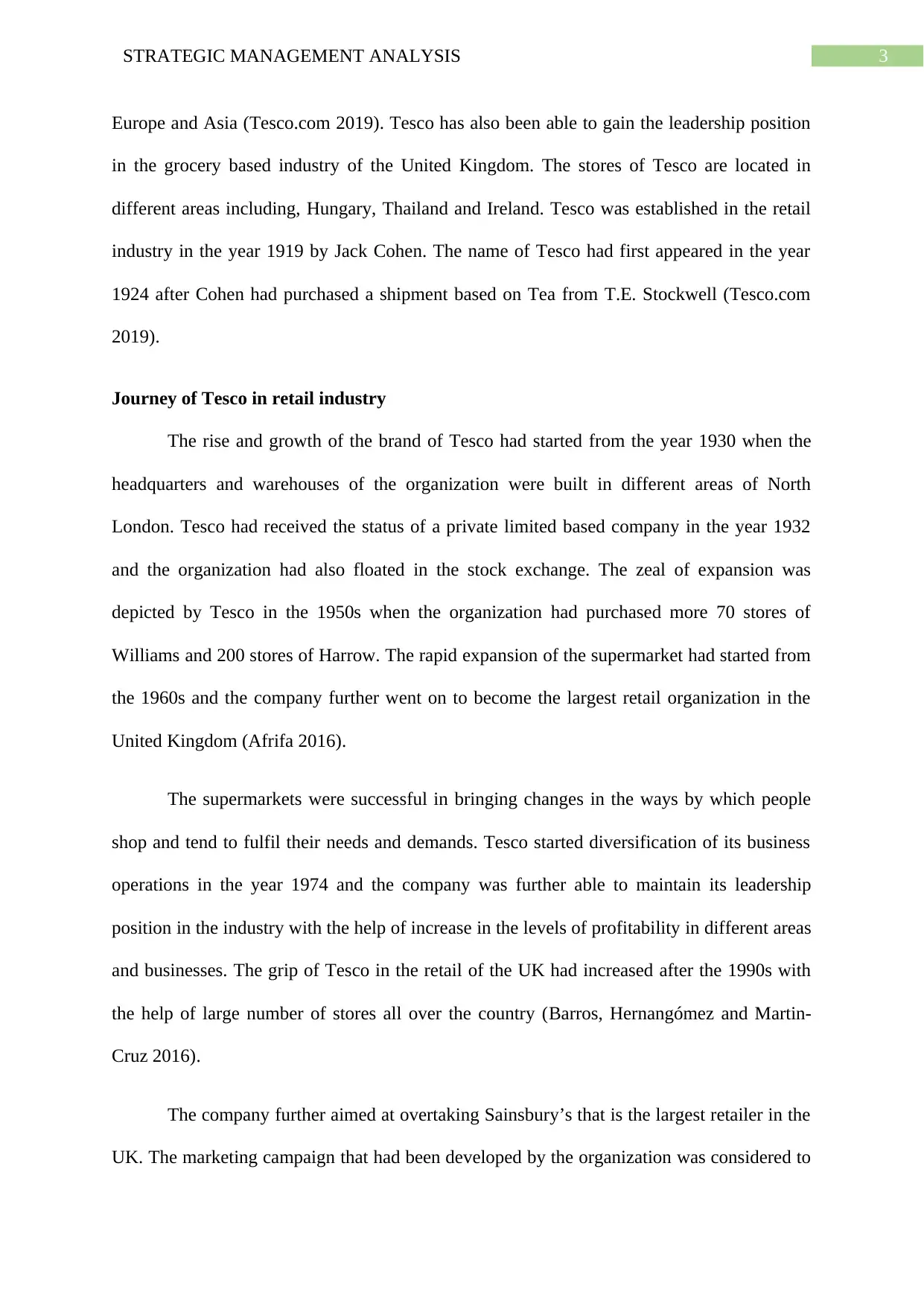
3STRATEGIC MANAGEMENT ANALYSIS
Europe and Asia (Tesco.com 2019). Tesco has also been able to gain the leadership position
in the grocery based industry of the United Kingdom. The stores of Tesco are located in
different areas including, Hungary, Thailand and Ireland. Tesco was established in the retail
industry in the year 1919 by Jack Cohen. The name of Tesco had first appeared in the year
1924 after Cohen had purchased a shipment based on Tea from T.E. Stockwell (Tesco.com
2019).
Journey of Tesco in retail industry
The rise and growth of the brand of Tesco had started from the year 1930 when the
headquarters and warehouses of the organization were built in different areas of North
London. Tesco had received the status of a private limited based company in the year 1932
and the organization had also floated in the stock exchange. The zeal of expansion was
depicted by Tesco in the 1950s when the organization had purchased more 70 stores of
Williams and 200 stores of Harrow. The rapid expansion of the supermarket had started from
the 1960s and the company further went on to become the largest retail organization in the
United Kingdom (Afrifa 2016).
The supermarkets were successful in bringing changes in the ways by which people
shop and tend to fulfil their needs and demands. Tesco started diversification of its business
operations in the year 1974 and the company was further able to maintain its leadership
position in the industry with the help of increase in the levels of profitability in different areas
and businesses. The grip of Tesco in the retail of the UK had increased after the 1990s with
the help of large number of stores all over the country (Barros, Hernangómez and Martin-
Cruz 2016).
The company further aimed at overtaking Sainsbury’s that is the largest retailer in the
UK. The marketing campaign that had been developed by the organization was considered to
Europe and Asia (Tesco.com 2019). Tesco has also been able to gain the leadership position
in the grocery based industry of the United Kingdom. The stores of Tesco are located in
different areas including, Hungary, Thailand and Ireland. Tesco was established in the retail
industry in the year 1919 by Jack Cohen. The name of Tesco had first appeared in the year
1924 after Cohen had purchased a shipment based on Tea from T.E. Stockwell (Tesco.com
2019).
Journey of Tesco in retail industry
The rise and growth of the brand of Tesco had started from the year 1930 when the
headquarters and warehouses of the organization were built in different areas of North
London. Tesco had received the status of a private limited based company in the year 1932
and the organization had also floated in the stock exchange. The zeal of expansion was
depicted by Tesco in the 1950s when the organization had purchased more 70 stores of
Williams and 200 stores of Harrow. The rapid expansion of the supermarket had started from
the 1960s and the company further went on to become the largest retail organization in the
United Kingdom (Afrifa 2016).
The supermarkets were successful in bringing changes in the ways by which people
shop and tend to fulfil their needs and demands. Tesco started diversification of its business
operations in the year 1974 and the company was further able to maintain its leadership
position in the industry with the help of increase in the levels of profitability in different areas
and businesses. The grip of Tesco in the retail of the UK had increased after the 1990s with
the help of large number of stores all over the country (Barros, Hernangómez and Martin-
Cruz 2016).
The company further aimed at overtaking Sainsbury’s that is the largest retailer in the
UK. The marketing campaign that had been developed by the organization was considered to
Paraphrase This Document
Need a fresh take? Get an instant paraphrase of this document with our AI Paraphraser
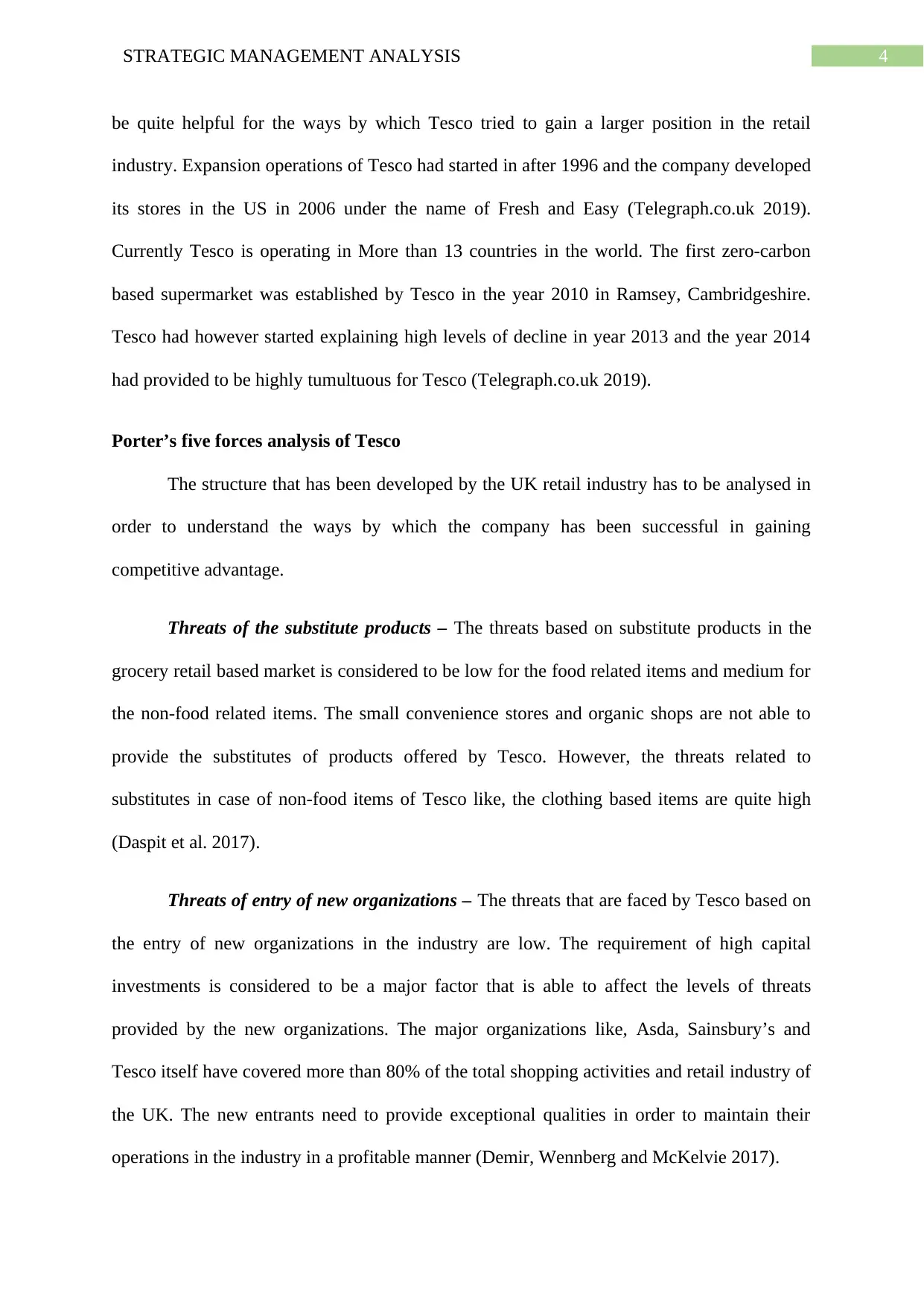
4STRATEGIC MANAGEMENT ANALYSIS
be quite helpful for the ways by which Tesco tried to gain a larger position in the retail
industry. Expansion operations of Tesco had started in after 1996 and the company developed
its stores in the US in 2006 under the name of Fresh and Easy (Telegraph.co.uk 2019).
Currently Tesco is operating in More than 13 countries in the world. The first zero-carbon
based supermarket was established by Tesco in the year 2010 in Ramsey, Cambridgeshire.
Tesco had however started explaining high levels of decline in year 2013 and the year 2014
had provided to be highly tumultuous for Tesco (Telegraph.co.uk 2019).
Porter’s five forces analysis of Tesco
The structure that has been developed by the UK retail industry has to be analysed in
order to understand the ways by which the company has been successful in gaining
competitive advantage.
Threats of the substitute products – The threats based on substitute products in the
grocery retail based market is considered to be low for the food related items and medium for
the non-food related items. The small convenience stores and organic shops are not able to
provide the substitutes of products offered by Tesco. However, the threats related to
substitutes in case of non-food items of Tesco like, the clothing based items are quite high
(Daspit et al. 2017).
Threats of entry of new organizations – The threats that are faced by Tesco based on
the entry of new organizations in the industry are low. The requirement of high capital
investments is considered to be a major factor that is able to affect the levels of threats
provided by the new organizations. The major organizations like, Asda, Sainsbury’s and
Tesco itself have covered more than 80% of the total shopping activities and retail industry of
the UK. The new entrants need to provide exceptional qualities in order to maintain their
operations in the industry in a profitable manner (Demir, Wennberg and McKelvie 2017).
be quite helpful for the ways by which Tesco tried to gain a larger position in the retail
industry. Expansion operations of Tesco had started in after 1996 and the company developed
its stores in the US in 2006 under the name of Fresh and Easy (Telegraph.co.uk 2019).
Currently Tesco is operating in More than 13 countries in the world. The first zero-carbon
based supermarket was established by Tesco in the year 2010 in Ramsey, Cambridgeshire.
Tesco had however started explaining high levels of decline in year 2013 and the year 2014
had provided to be highly tumultuous for Tesco (Telegraph.co.uk 2019).
Porter’s five forces analysis of Tesco
The structure that has been developed by the UK retail industry has to be analysed in
order to understand the ways by which the company has been successful in gaining
competitive advantage.
Threats of the substitute products – The threats based on substitute products in the
grocery retail based market is considered to be low for the food related items and medium for
the non-food related items. The small convenience stores and organic shops are not able to
provide the substitutes of products offered by Tesco. However, the threats related to
substitutes in case of non-food items of Tesco like, the clothing based items are quite high
(Daspit et al. 2017).
Threats of entry of new organizations – The threats that are faced by Tesco based on
the entry of new organizations in the industry are low. The requirement of high capital
investments is considered to be a major factor that is able to affect the levels of threats
provided by the new organizations. The major organizations like, Asda, Sainsbury’s and
Tesco itself have covered more than 80% of the total shopping activities and retail industry of
the UK. The new entrants need to provide exceptional qualities in order to maintain their
operations in the industry in a profitable manner (Demir, Wennberg and McKelvie 2017).
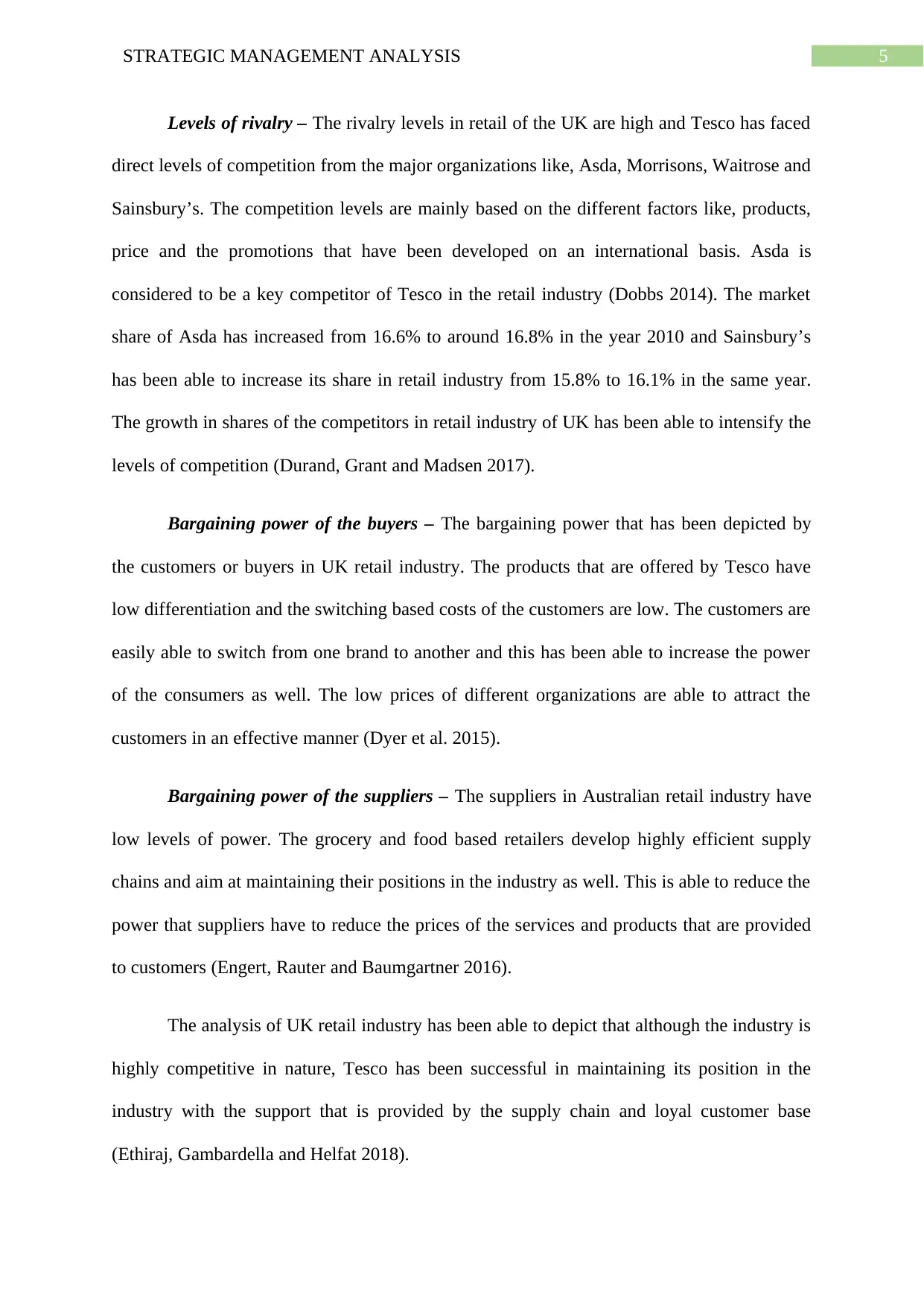
5STRATEGIC MANAGEMENT ANALYSIS
Levels of rivalry – The rivalry levels in retail of the UK are high and Tesco has faced
direct levels of competition from the major organizations like, Asda, Morrisons, Waitrose and
Sainsbury’s. The competition levels are mainly based on the different factors like, products,
price and the promotions that have been developed on an international basis. Asda is
considered to be a key competitor of Tesco in the retail industry (Dobbs 2014). The market
share of Asda has increased from 16.6% to around 16.8% in the year 2010 and Sainsbury’s
has been able to increase its share in retail industry from 15.8% to 16.1% in the same year.
The growth in shares of the competitors in retail industry of UK has been able to intensify the
levels of competition (Durand, Grant and Madsen 2017).
Bargaining power of the buyers – The bargaining power that has been depicted by
the customers or buyers in UK retail industry. The products that are offered by Tesco have
low differentiation and the switching based costs of the customers are low. The customers are
easily able to switch from one brand to another and this has been able to increase the power
of the consumers as well. The low prices of different organizations are able to attract the
customers in an effective manner (Dyer et al. 2015).
Bargaining power of the suppliers – The suppliers in Australian retail industry have
low levels of power. The grocery and food based retailers develop highly efficient supply
chains and aim at maintaining their positions in the industry as well. This is able to reduce the
power that suppliers have to reduce the prices of the services and products that are provided
to customers (Engert, Rauter and Baumgartner 2016).
The analysis of UK retail industry has been able to depict that although the industry is
highly competitive in nature, Tesco has been successful in maintaining its position in the
industry with the support that is provided by the supply chain and loyal customer base
(Ethiraj, Gambardella and Helfat 2018).
Levels of rivalry – The rivalry levels in retail of the UK are high and Tesco has faced
direct levels of competition from the major organizations like, Asda, Morrisons, Waitrose and
Sainsbury’s. The competition levels are mainly based on the different factors like, products,
price and the promotions that have been developed on an international basis. Asda is
considered to be a key competitor of Tesco in the retail industry (Dobbs 2014). The market
share of Asda has increased from 16.6% to around 16.8% in the year 2010 and Sainsbury’s
has been able to increase its share in retail industry from 15.8% to 16.1% in the same year.
The growth in shares of the competitors in retail industry of UK has been able to intensify the
levels of competition (Durand, Grant and Madsen 2017).
Bargaining power of the buyers – The bargaining power that has been depicted by
the customers or buyers in UK retail industry. The products that are offered by Tesco have
low differentiation and the switching based costs of the customers are low. The customers are
easily able to switch from one brand to another and this has been able to increase the power
of the consumers as well. The low prices of different organizations are able to attract the
customers in an effective manner (Dyer et al. 2015).
Bargaining power of the suppliers – The suppliers in Australian retail industry have
low levels of power. The grocery and food based retailers develop highly efficient supply
chains and aim at maintaining their positions in the industry as well. This is able to reduce the
power that suppliers have to reduce the prices of the services and products that are provided
to customers (Engert, Rauter and Baumgartner 2016).
The analysis of UK retail industry has been able to depict that although the industry is
highly competitive in nature, Tesco has been successful in maintaining its position in the
industry with the support that is provided by the supply chain and loyal customer base
(Ethiraj, Gambardella and Helfat 2018).
⊘ This is a preview!⊘
Do you want full access?
Subscribe today to unlock all pages.

Trusted by 1+ million students worldwide
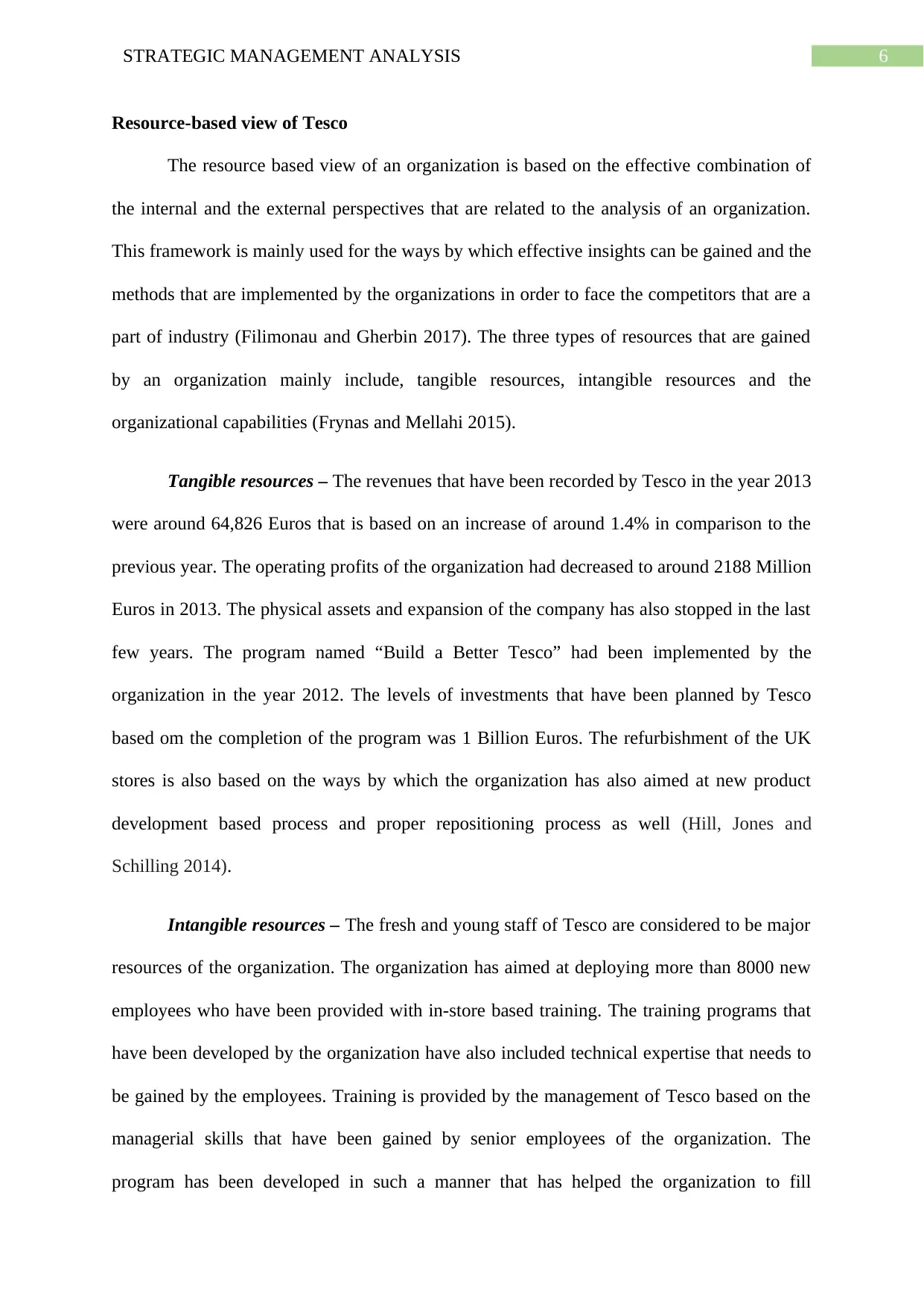
6STRATEGIC MANAGEMENT ANALYSIS
Resource-based view of Tesco
The resource based view of an organization is based on the effective combination of
the internal and the external perspectives that are related to the analysis of an organization.
This framework is mainly used for the ways by which effective insights can be gained and the
methods that are implemented by the organizations in order to face the competitors that are a
part of industry (Filimonau and Gherbin 2017). The three types of resources that are gained
by an organization mainly include, tangible resources, intangible resources and the
organizational capabilities (Frynas and Mellahi 2015).
Tangible resources – The revenues that have been recorded by Tesco in the year 2013
were around 64,826 Euros that is based on an increase of around 1.4% in comparison to the
previous year. The operating profits of the organization had decreased to around 2188 Million
Euros in 2013. The physical assets and expansion of the company has also stopped in the last
few years. The program named “Build a Better Tesco” had been implemented by the
organization in the year 2012. The levels of investments that have been planned by Tesco
based om the completion of the program was 1 Billion Euros. The refurbishment of the UK
stores is also based on the ways by which the organization has also aimed at new product
development based process and proper repositioning process as well (Hill, Jones and
Schilling 2014).
Intangible resources – The fresh and young staff of Tesco are considered to be major
resources of the organization. The organization has aimed at deploying more than 8000 new
employees who have been provided with in-store based training. The training programs that
have been developed by the organization have also included technical expertise that needs to
be gained by the employees. Training is provided by the management of Tesco based on the
managerial skills that have been gained by senior employees of the organization. The
program has been developed in such a manner that has helped the organization to fill
Resource-based view of Tesco
The resource based view of an organization is based on the effective combination of
the internal and the external perspectives that are related to the analysis of an organization.
This framework is mainly used for the ways by which effective insights can be gained and the
methods that are implemented by the organizations in order to face the competitors that are a
part of industry (Filimonau and Gherbin 2017). The three types of resources that are gained
by an organization mainly include, tangible resources, intangible resources and the
organizational capabilities (Frynas and Mellahi 2015).
Tangible resources – The revenues that have been recorded by Tesco in the year 2013
were around 64,826 Euros that is based on an increase of around 1.4% in comparison to the
previous year. The operating profits of the organization had decreased to around 2188 Million
Euros in 2013. The physical assets and expansion of the company has also stopped in the last
few years. The program named “Build a Better Tesco” had been implemented by the
organization in the year 2012. The levels of investments that have been planned by Tesco
based om the completion of the program was 1 Billion Euros. The refurbishment of the UK
stores is also based on the ways by which the organization has also aimed at new product
development based process and proper repositioning process as well (Hill, Jones and
Schilling 2014).
Intangible resources – The fresh and young staff of Tesco are considered to be major
resources of the organization. The organization has aimed at deploying more than 8000 new
employees who have been provided with in-store based training. The training programs that
have been developed by the organization have also included technical expertise that needs to
be gained by the employees. Training is provided by the management of Tesco based on the
managerial skills that have been gained by senior employees of the organization. The
program has been developed in such a manner that has helped the organization to fill
Paraphrase This Document
Need a fresh take? Get an instant paraphrase of this document with our AI Paraphraser
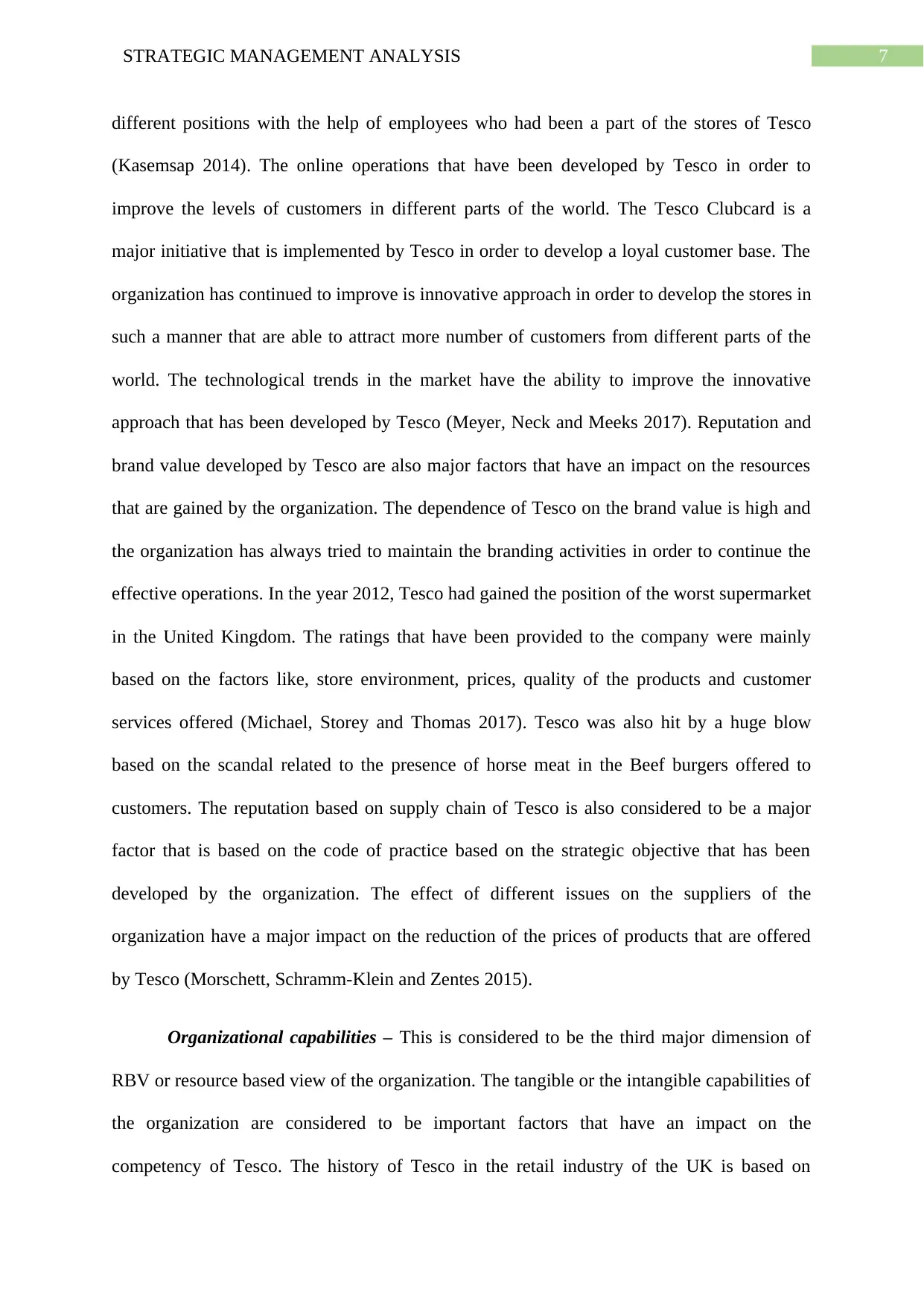
7STRATEGIC MANAGEMENT ANALYSIS
different positions with the help of employees who had been a part of the stores of Tesco
(Kasemsap 2014). The online operations that have been developed by Tesco in order to
improve the levels of customers in different parts of the world. The Tesco Clubcard is a
major initiative that is implemented by Tesco in order to develop a loyal customer base. The
organization has continued to improve is innovative approach in order to develop the stores in
such a manner that are able to attract more number of customers from different parts of the
world. The technological trends in the market have the ability to improve the innovative
approach that has been developed by Tesco (Meyer, Neck and Meeks 2017). Reputation and
brand value developed by Tesco are also major factors that have an impact on the resources
that are gained by the organization. The dependence of Tesco on the brand value is high and
the organization has always tried to maintain the branding activities in order to continue the
effective operations. In the year 2012, Tesco had gained the position of the worst supermarket
in the United Kingdom. The ratings that have been provided to the company were mainly
based on the factors like, store environment, prices, quality of the products and customer
services offered (Michael, Storey and Thomas 2017). Tesco was also hit by a huge blow
based on the scandal related to the presence of horse meat in the Beef burgers offered to
customers. The reputation based on supply chain of Tesco is also considered to be a major
factor that is based on the code of practice based on the strategic objective that has been
developed by the organization. The effect of different issues on the suppliers of the
organization have a major impact on the reduction of the prices of products that are offered
by Tesco (Morschett, Schramm-Klein and Zentes 2015).
Organizational capabilities – This is considered to be the third major dimension of
RBV or resource based view of the organization. The tangible or the intangible capabilities of
the organization are considered to be important factors that have an impact on the
competency of Tesco. The history of Tesco in the retail industry of the UK is based on
different positions with the help of employees who had been a part of the stores of Tesco
(Kasemsap 2014). The online operations that have been developed by Tesco in order to
improve the levels of customers in different parts of the world. The Tesco Clubcard is a
major initiative that is implemented by Tesco in order to develop a loyal customer base. The
organization has continued to improve is innovative approach in order to develop the stores in
such a manner that are able to attract more number of customers from different parts of the
world. The technological trends in the market have the ability to improve the innovative
approach that has been developed by Tesco (Meyer, Neck and Meeks 2017). Reputation and
brand value developed by Tesco are also major factors that have an impact on the resources
that are gained by the organization. The dependence of Tesco on the brand value is high and
the organization has always tried to maintain the branding activities in order to continue the
effective operations. In the year 2012, Tesco had gained the position of the worst supermarket
in the United Kingdom. The ratings that have been provided to the company were mainly
based on the factors like, store environment, prices, quality of the products and customer
services offered (Michael, Storey and Thomas 2017). Tesco was also hit by a huge blow
based on the scandal related to the presence of horse meat in the Beef burgers offered to
customers. The reputation based on supply chain of Tesco is also considered to be a major
factor that is based on the code of practice based on the strategic objective that has been
developed by the organization. The effect of different issues on the suppliers of the
organization have a major impact on the reduction of the prices of products that are offered
by Tesco (Morschett, Schramm-Klein and Zentes 2015).
Organizational capabilities – This is considered to be the third major dimension of
RBV or resource based view of the organization. The tangible or the intangible capabilities of
the organization are considered to be important factors that have an impact on the
competency of Tesco. The history of Tesco in the retail industry of the UK is based on
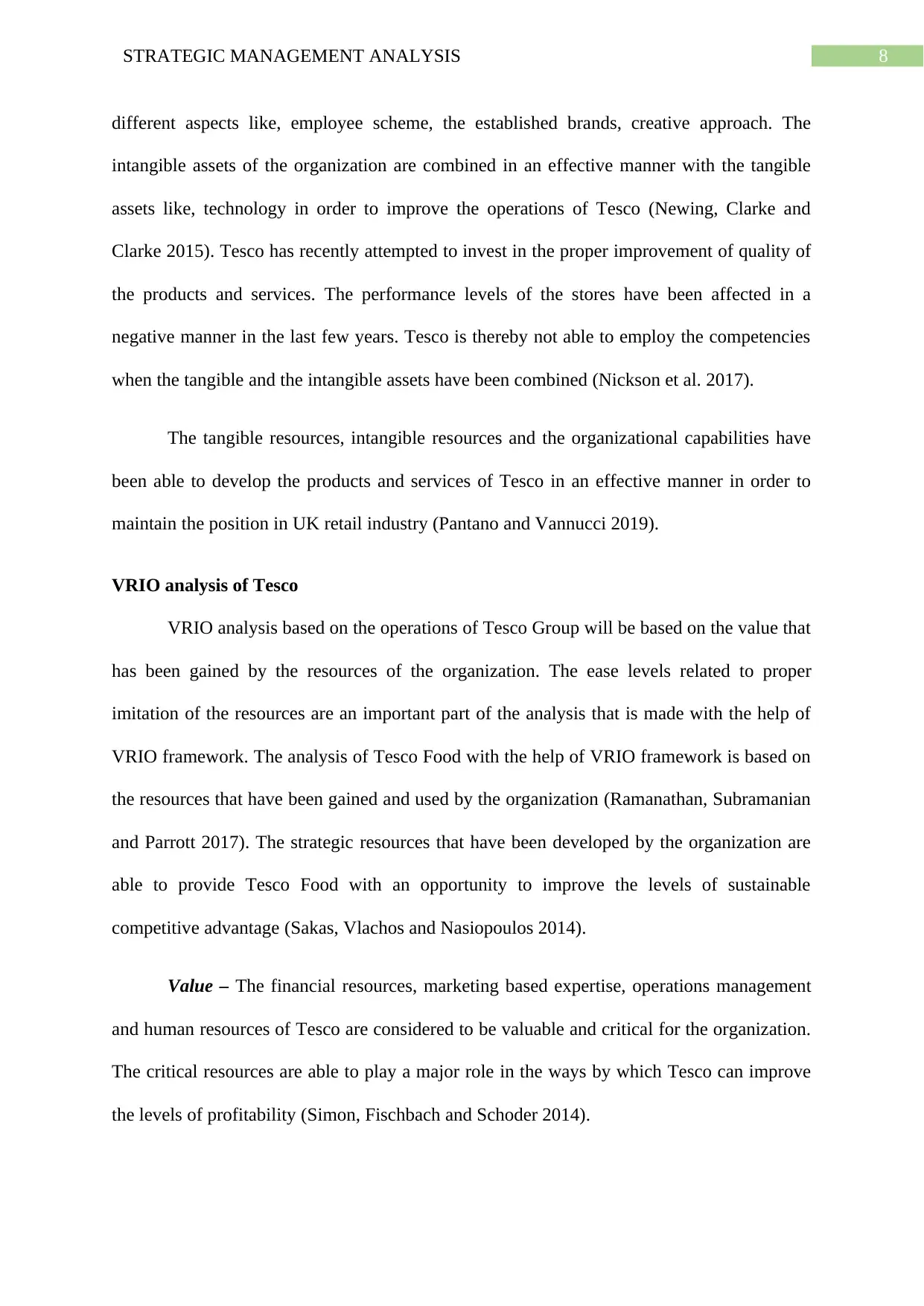
8STRATEGIC MANAGEMENT ANALYSIS
different aspects like, employee scheme, the established brands, creative approach. The
intangible assets of the organization are combined in an effective manner with the tangible
assets like, technology in order to improve the operations of Tesco (Newing, Clarke and
Clarke 2015). Tesco has recently attempted to invest in the proper improvement of quality of
the products and services. The performance levels of the stores have been affected in a
negative manner in the last few years. Tesco is thereby not able to employ the competencies
when the tangible and the intangible assets have been combined (Nickson et al. 2017).
The tangible resources, intangible resources and the organizational capabilities have
been able to develop the products and services of Tesco in an effective manner in order to
maintain the position in UK retail industry (Pantano and Vannucci 2019).
VRIO analysis of Tesco
VRIO analysis based on the operations of Tesco Group will be based on the value that
has been gained by the resources of the organization. The ease levels related to proper
imitation of the resources are an important part of the analysis that is made with the help of
VRIO framework. The analysis of Tesco Food with the help of VRIO framework is based on
the resources that have been gained and used by the organization (Ramanathan, Subramanian
and Parrott 2017). The strategic resources that have been developed by the organization are
able to provide Tesco Food with an opportunity to improve the levels of sustainable
competitive advantage (Sakas, Vlachos and Nasiopoulos 2014).
Value – The financial resources, marketing based expertise, operations management
and human resources of Tesco are considered to be valuable and critical for the organization.
The critical resources are able to play a major role in the ways by which Tesco can improve
the levels of profitability (Simon, Fischbach and Schoder 2014).
different aspects like, employee scheme, the established brands, creative approach. The
intangible assets of the organization are combined in an effective manner with the tangible
assets like, technology in order to improve the operations of Tesco (Newing, Clarke and
Clarke 2015). Tesco has recently attempted to invest in the proper improvement of quality of
the products and services. The performance levels of the stores have been affected in a
negative manner in the last few years. Tesco is thereby not able to employ the competencies
when the tangible and the intangible assets have been combined (Nickson et al. 2017).
The tangible resources, intangible resources and the organizational capabilities have
been able to develop the products and services of Tesco in an effective manner in order to
maintain the position in UK retail industry (Pantano and Vannucci 2019).
VRIO analysis of Tesco
VRIO analysis based on the operations of Tesco Group will be based on the value that
has been gained by the resources of the organization. The ease levels related to proper
imitation of the resources are an important part of the analysis that is made with the help of
VRIO framework. The analysis of Tesco Food with the help of VRIO framework is based on
the resources that have been gained and used by the organization (Ramanathan, Subramanian
and Parrott 2017). The strategic resources that have been developed by the organization are
able to provide Tesco Food with an opportunity to improve the levels of sustainable
competitive advantage (Sakas, Vlachos and Nasiopoulos 2014).
Value – The financial resources, marketing based expertise, operations management
and human resources of Tesco are considered to be valuable and critical for the organization.
The critical resources are able to play a major role in the ways by which Tesco can improve
the levels of profitability (Simon, Fischbach and Schoder 2014).
⊘ This is a preview!⊘
Do you want full access?
Subscribe today to unlock all pages.

Trusted by 1+ million students worldwide
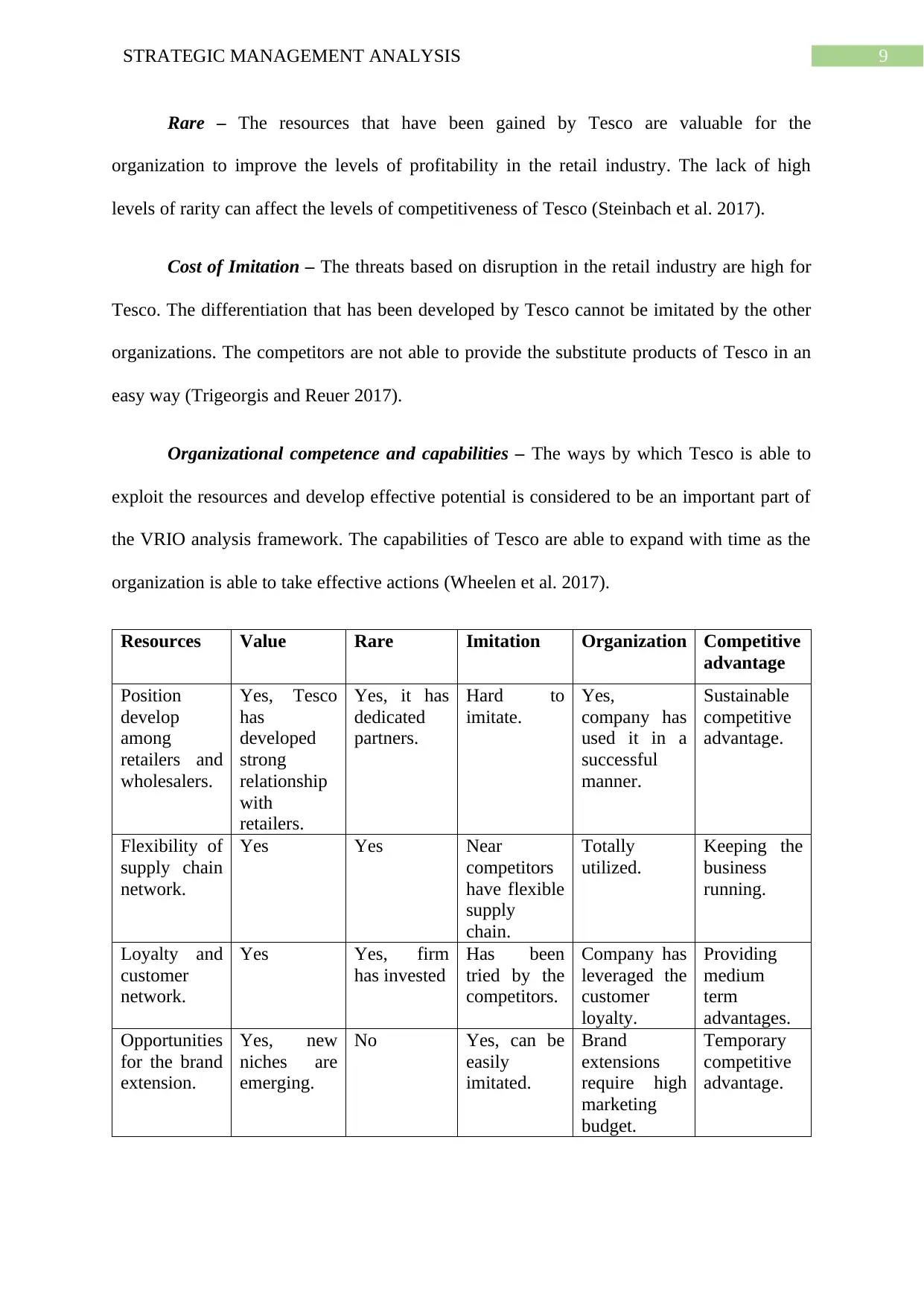
9STRATEGIC MANAGEMENT ANALYSIS
Rare – The resources that have been gained by Tesco are valuable for the
organization to improve the levels of profitability in the retail industry. The lack of high
levels of rarity can affect the levels of competitiveness of Tesco (Steinbach et al. 2017).
Cost of Imitation – The threats based on disruption in the retail industry are high for
Tesco. The differentiation that has been developed by Tesco cannot be imitated by the other
organizations. The competitors are not able to provide the substitute products of Tesco in an
easy way (Trigeorgis and Reuer 2017).
Organizational competence and capabilities – The ways by which Tesco is able to
exploit the resources and develop effective potential is considered to be an important part of
the VRIO analysis framework. The capabilities of Tesco are able to expand with time as the
organization is able to take effective actions (Wheelen et al. 2017).
Resources Value Rare Imitation Organization Competitive
advantage
Position
develop
among
retailers and
wholesalers.
Yes, Tesco
has
developed
strong
relationship
with
retailers.
Yes, it has
dedicated
partners.
Hard to
imitate.
Yes,
company has
used it in a
successful
manner.
Sustainable
competitive
advantage.
Flexibility of
supply chain
network.
Yes Yes Near
competitors
have flexible
supply
chain.
Totally
utilized.
Keeping the
business
running.
Loyalty and
customer
network.
Yes Yes, firm
has invested
Has been
tried by the
competitors.
Company has
leveraged the
customer
loyalty.
Providing
medium
term
advantages.
Opportunities
for the brand
extension.
Yes, new
niches are
emerging.
No Yes, can be
easily
imitated.
Brand
extensions
require high
marketing
budget.
Temporary
competitive
advantage.
Rare – The resources that have been gained by Tesco are valuable for the
organization to improve the levels of profitability in the retail industry. The lack of high
levels of rarity can affect the levels of competitiveness of Tesco (Steinbach et al. 2017).
Cost of Imitation – The threats based on disruption in the retail industry are high for
Tesco. The differentiation that has been developed by Tesco cannot be imitated by the other
organizations. The competitors are not able to provide the substitute products of Tesco in an
easy way (Trigeorgis and Reuer 2017).
Organizational competence and capabilities – The ways by which Tesco is able to
exploit the resources and develop effective potential is considered to be an important part of
the VRIO analysis framework. The capabilities of Tesco are able to expand with time as the
organization is able to take effective actions (Wheelen et al. 2017).
Resources Value Rare Imitation Organization Competitive
advantage
Position
develop
among
retailers and
wholesalers.
Yes, Tesco
has
developed
strong
relationship
with
retailers.
Yes, it has
dedicated
partners.
Hard to
imitate.
Yes,
company has
used it in a
successful
manner.
Sustainable
competitive
advantage.
Flexibility of
supply chain
network.
Yes Yes Near
competitors
have flexible
supply
chain.
Totally
utilized.
Keeping the
business
running.
Loyalty and
customer
network.
Yes Yes, firm
has invested
Has been
tried by the
competitors.
Company has
leveraged the
customer
loyalty.
Providing
medium
term
advantages.
Opportunities
for the brand
extension.
Yes, new
niches are
emerging.
No Yes, can be
easily
imitated.
Brand
extensions
require high
marketing
budget.
Temporary
competitive
advantage.
Paraphrase This Document
Need a fresh take? Get an instant paraphrase of this document with our AI Paraphraser
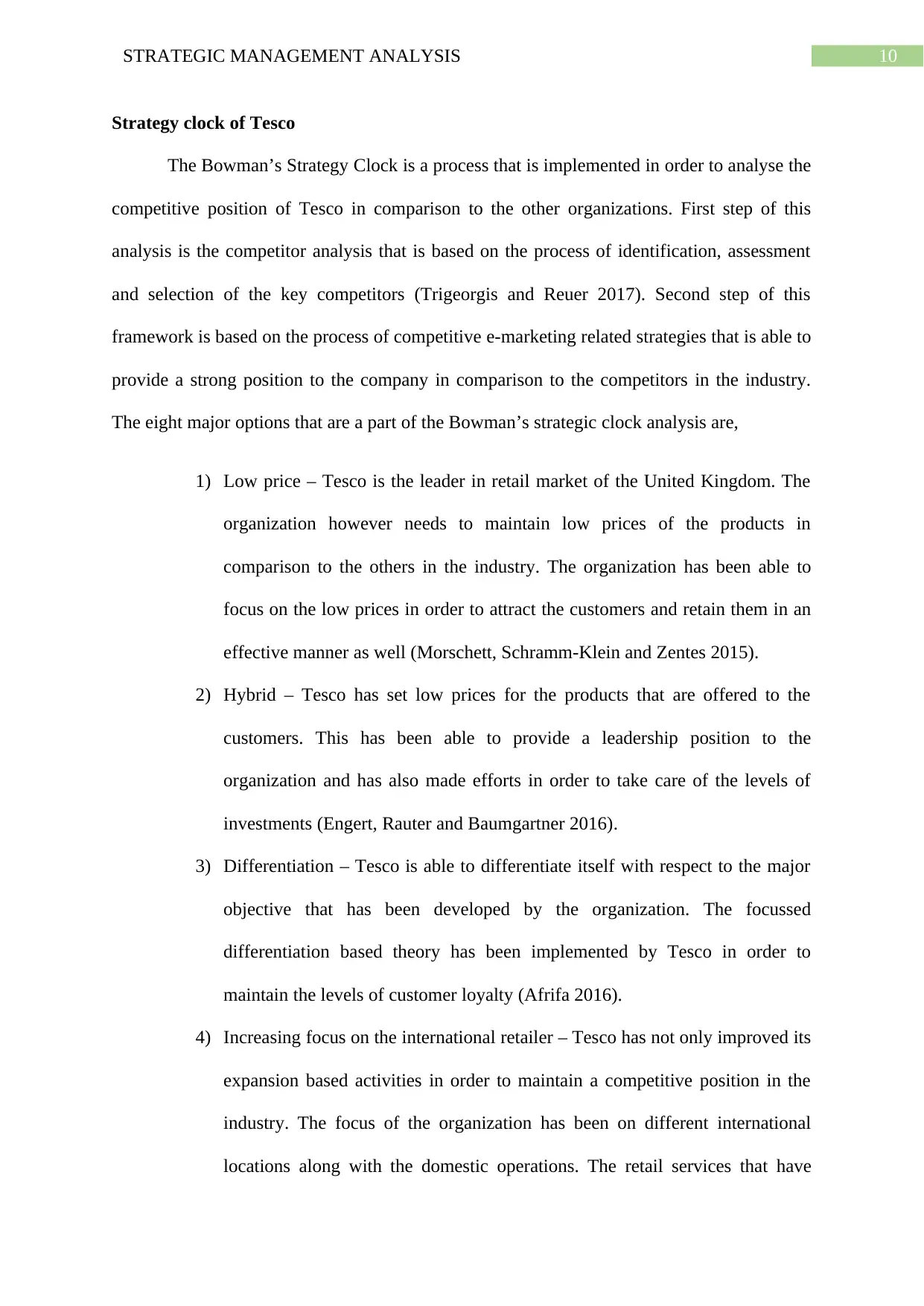
10STRATEGIC MANAGEMENT ANALYSIS
Strategy clock of Tesco
The Bowman’s Strategy Clock is a process that is implemented in order to analyse the
competitive position of Tesco in comparison to the other organizations. First step of this
analysis is the competitor analysis that is based on the process of identification, assessment
and selection of the key competitors (Trigeorgis and Reuer 2017). Second step of this
framework is based on the process of competitive e-marketing related strategies that is able to
provide a strong position to the company in comparison to the competitors in the industry.
The eight major options that are a part of the Bowman’s strategic clock analysis are,
1) Low price – Tesco is the leader in retail market of the United Kingdom. The
organization however needs to maintain low prices of the products in
comparison to the others in the industry. The organization has been able to
focus on the low prices in order to attract the customers and retain them in an
effective manner as well (Morschett, Schramm-Klein and Zentes 2015).
2) Hybrid – Tesco has set low prices for the products that are offered to the
customers. This has been able to provide a leadership position to the
organization and has also made efforts in order to take care of the levels of
investments (Engert, Rauter and Baumgartner 2016).
3) Differentiation – Tesco is able to differentiate itself with respect to the major
objective that has been developed by the organization. The focussed
differentiation based theory has been implemented by Tesco in order to
maintain the levels of customer loyalty (Afrifa 2016).
4) Increasing focus on the international retailer – Tesco has not only improved its
expansion based activities in order to maintain a competitive position in the
industry. The focus of the organization has been on different international
locations along with the domestic operations. The retail services that have
Strategy clock of Tesco
The Bowman’s Strategy Clock is a process that is implemented in order to analyse the
competitive position of Tesco in comparison to the other organizations. First step of this
analysis is the competitor analysis that is based on the process of identification, assessment
and selection of the key competitors (Trigeorgis and Reuer 2017). Second step of this
framework is based on the process of competitive e-marketing related strategies that is able to
provide a strong position to the company in comparison to the competitors in the industry.
The eight major options that are a part of the Bowman’s strategic clock analysis are,
1) Low price – Tesco is the leader in retail market of the United Kingdom. The
organization however needs to maintain low prices of the products in
comparison to the others in the industry. The organization has been able to
focus on the low prices in order to attract the customers and retain them in an
effective manner as well (Morschett, Schramm-Klein and Zentes 2015).
2) Hybrid – Tesco has set low prices for the products that are offered to the
customers. This has been able to provide a leadership position to the
organization and has also made efforts in order to take care of the levels of
investments (Engert, Rauter and Baumgartner 2016).
3) Differentiation – Tesco is able to differentiate itself with respect to the major
objective that has been developed by the organization. The focussed
differentiation based theory has been implemented by Tesco in order to
maintain the levels of customer loyalty (Afrifa 2016).
4) Increasing focus on the international retailer – Tesco has not only improved its
expansion based activities in order to maintain a competitive position in the
industry. The focus of the organization has been on different international
locations along with the domestic operations. The retail services that have
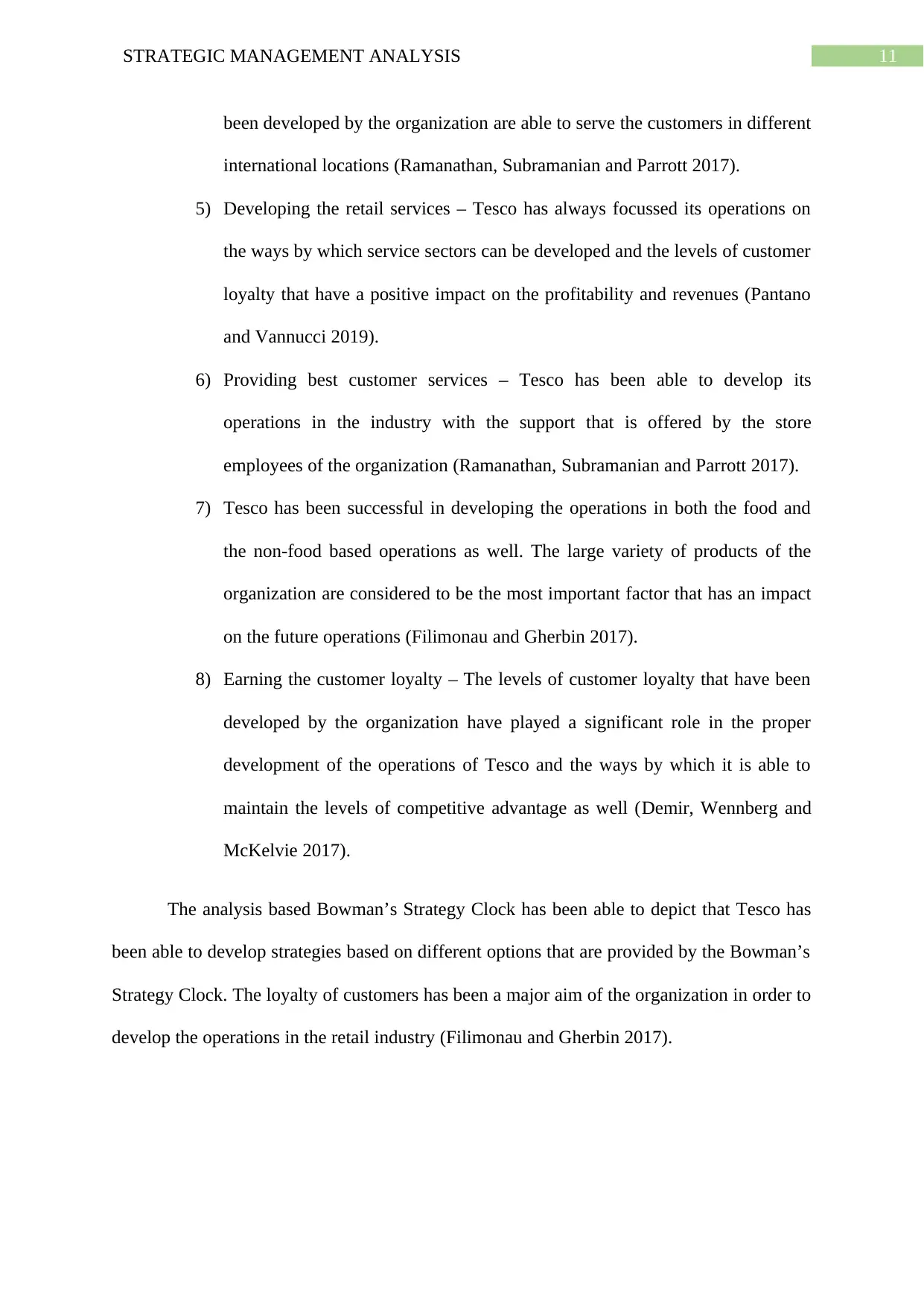
11STRATEGIC MANAGEMENT ANALYSIS
been developed by the organization are able to serve the customers in different
international locations (Ramanathan, Subramanian and Parrott 2017).
5) Developing the retail services – Tesco has always focussed its operations on
the ways by which service sectors can be developed and the levels of customer
loyalty that have a positive impact on the profitability and revenues (Pantano
and Vannucci 2019).
6) Providing best customer services – Tesco has been able to develop its
operations in the industry with the support that is offered by the store
employees of the organization (Ramanathan, Subramanian and Parrott 2017).
7) Tesco has been successful in developing the operations in both the food and
the non-food based operations as well. The large variety of products of the
organization are considered to be the most important factor that has an impact
on the future operations (Filimonau and Gherbin 2017).
8) Earning the customer loyalty – The levels of customer loyalty that have been
developed by the organization have played a significant role in the proper
development of the operations of Tesco and the ways by which it is able to
maintain the levels of competitive advantage as well (Demir, Wennberg and
McKelvie 2017).
The analysis based Bowman’s Strategy Clock has been able to depict that Tesco has
been able to develop strategies based on different options that are provided by the Bowman’s
Strategy Clock. The loyalty of customers has been a major aim of the organization in order to
develop the operations in the retail industry (Filimonau and Gherbin 2017).
been developed by the organization are able to serve the customers in different
international locations (Ramanathan, Subramanian and Parrott 2017).
5) Developing the retail services – Tesco has always focussed its operations on
the ways by which service sectors can be developed and the levels of customer
loyalty that have a positive impact on the profitability and revenues (Pantano
and Vannucci 2019).
6) Providing best customer services – Tesco has been able to develop its
operations in the industry with the support that is offered by the store
employees of the organization (Ramanathan, Subramanian and Parrott 2017).
7) Tesco has been successful in developing the operations in both the food and
the non-food based operations as well. The large variety of products of the
organization are considered to be the most important factor that has an impact
on the future operations (Filimonau and Gherbin 2017).
8) Earning the customer loyalty – The levels of customer loyalty that have been
developed by the organization have played a significant role in the proper
development of the operations of Tesco and the ways by which it is able to
maintain the levels of competitive advantage as well (Demir, Wennberg and
McKelvie 2017).
The analysis based Bowman’s Strategy Clock has been able to depict that Tesco has
been able to develop strategies based on different options that are provided by the Bowman’s
Strategy Clock. The loyalty of customers has been a major aim of the organization in order to
develop the operations in the retail industry (Filimonau and Gherbin 2017).
⊘ This is a preview!⊘
Do you want full access?
Subscribe today to unlock all pages.

Trusted by 1+ million students worldwide
1 out of 18
Related Documents
Your All-in-One AI-Powered Toolkit for Academic Success.
+13062052269
info@desklib.com
Available 24*7 on WhatsApp / Email
![[object Object]](/_next/static/media/star-bottom.7253800d.svg)
Unlock your academic potential
Copyright © 2020–2025 A2Z Services. All Rights Reserved. Developed and managed by ZUCOL.




